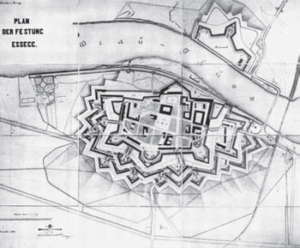Eszék

Eszék (Osijek, Essegg) used to be guarding the Kingdom of Hungary against the south. Let us not forget that the Kingdom of Croatia and the Kingdom of Hungary had been in Personal Union for 816 years. Now, it is in Croatia. You can find it on My Google Maps:
https://www.google.com/maps/d/edit?mid=1Ao2OxXIrmW_S5ny9phYw8oL_mONmz3Y&usp=sharing

The town was a feudal property of the Hungarian Kórógyi family between 1353 and 1472. It is assumed that the Kórógyi family built some kind of walled fortification in Eszék. According to Croatian historian Ive Mažuran, this castle, with its strong walls and corner towers, stood near the medieval Church of the Holy Trinity, whose foundations were found next to the present-day Franciscan Church of the Holy Cross. It had gates at Valpo and Valkovar, leading towards the Drava, the river port and crossing point. The castle was surrounded by ramparts with drawbridges over them.

After the death of the last Kórógyi, King Matthias Corvinus granted it to the Rozgonyi family. The city and the previous bridge of Eszék were destroyed by the Ottoman conquerors on 8 August 1526. The Ottomans defeated the Habsburgs’ army here in 1537, the Imperials were led by General Katzianer.

The Turks rebuilt the town in Ottoman oriental style and it was mentioned in the Ottoman census of 1579. The central part of the settlement was surrounded by stone walls reinforced by semicircular towers and surrounded by wide ramparts flooded by the waters of the Drava. Around the core of the town, to the south and west, a less important part of the settlement was formed, which was defended by a belt of palisades, sometimes with semicircular and square towers. The new fortress was about twice the size of its medieval predecessor. The castle’s army consisted of almost a thousand assault and light cavalry.

Eszék was divided into three contiguous parts – the castle, the town, and the palisade. As the center of the town, the castle stood near the bank of the Drava (between the present Franjevačka and Fakultetska streets and the Church of the Holy Cross). To the east, south, and west of it stretched the town, which roughly corresponded to the present fortress. The town was also fortified with a rampart wall and moats. It had two gates, with drawbridges, the Valpó and Valkóvár gates (sometimes called Nándorfehérvár). The most important buildings were the mosque of Casim Pasha, the court, the clock tower at the beginning of Križanić Square, and another mosque near the Valkóvár gate.

There were about 300 houses in the town, built of stone, wood, and brick. The city was divided into seven “mahallas” and the streets were paved with cobblestones. To the south and southwest of the city were fortified palisades with palisades and ramparts. This defensive system covered the area of the city between the present fortress, the road to Baranya, the surrounding parks, and King Zvonimir Street. Those arriving from the bridge over the Drava arrived at the stockade near the western wall of the town. The palisade had two gates. Here was the commercial and business center of Turkish-era Eszék. It had six trading inns and a caravanserai. There were also numerous shops and workshops, and probably more than 2,000 houses built of wood or brick.

Its most important buildings were the “hamam”, the well of Qasim Pasha, the mosque of Mustafa Pasha, the medrese and the mekteb, and the cemetery to the left of the bazaar gate, where the present health center stands. In addition to these, there were several other wells and mosques. To the south of the palisade was a huge bazaar building, and to the south and west of it was the famous fairground of Eszék. To the west of the fairground was the Bajram-Babina cemetery, and to the east of the palanquin was another cemetery.

In 1566, Sultan Suleiman built a famous, 8-kilometer-long wooden bridge of boats in Eszék, considered at that time to be one of the wonders of the world. It was one of the most important crossing places and had a major role in the logistics of the Ottoman army. In the Ottoman Empire, Eszék was part of the Budin Vilayet. General Pálffy Miklós managed to burn the bridge in 1599 and Zrínyi Miklós (also known as Nikola VII. Zrinski, the great-grandson of Nikola Subic Zrinski / Zrínyi Miklós, the hero of Szigetvár castle in 1566) did the same in 1664 during his famous Winter Campaign. It was how he wanted to cut the Ottoman logistic lines to recapture Nagykanizsa castle. Sadly, his efforts were sabotaged by the Habsburgs but he received the Golden Fleece for his heroic deed. You can read more about Zrínyi’s deed here:
https://www.hungarianottomanwars.com/1541-1699/the-famous-winter-campaign-of-zrinyi-1664/

On 7 June 1683, the Grand Vizier Kara Mustafa received here Thököly Imre, who came to pay a visit. In 1685, General Leslie occupied the palisade and the bridge was set on fire. In 1686, the bridge was burnt again by a Christian army led by Louis of Baden. The palisade burned for two days on 3 and 4 October and was never rebuilt.
19 July 1687 The defeat of the imperial troops at Eszék
After the capture of Buda in 1686, the troops of the Holy League occupied the Danube region as far as the Dráva River and a considerable part of the Great Plain practically unhindered. However, some strongholds such as Fehérvár, Szigetvár, Kanizsa, Várad, and Eger remained firmly in Ottoman hands. Thököly’s principality of Upper Hungary had also collapsed, but Transylvania had not yet dared to break openly with the Porte. In this mixed situation, the war plan for the following year was also somewhat confused.

The Emperor and King Leopold I made Belgrade, formerly known as Nándorfehérvár, the objective of the imperial army. The army’s leaders, Charles of Lotharingia and Louis of Baden were against it, saying that with a solid Turkish stronghold at their backs, it would be foolish to aim so far. Charles, the ‘silent prince’, would have preferred to march on Eger, while Louis would have preferred to besiege Szigetvár. But the emperor rejected this, instead sending Charles to Eszék along the Danube, while the 20,000-strong corps under the nominal command of Bavarian elector Maximilian Emmanuel, led by Louis of Baden, was sent against Pétervárad along the River Tisza.

Charles of Lotharingia arrived at the camp in Esztergom on 2 June, where he had only 15,000 soldiers instead of the promised 40,000. Nevertheless, he moved his army along the Danube as ordered, but Louis of Baden did not join him despite the request.

On 24 June, the main force, already at Dárda near the River Dráva, pushed back the advancing Turkish outposts across the river. The other army corps had only just started from under Szolnok, although the Grand Vizier, Suleiman Szári, was already at Pétervárad.
The two leaders stormed the War Council of Vienna by adopting their war plan, and Louis asked the emperor to send Prince Charles to besiege Szigetvár, and after its capture, to take Várad together. The ‘silent prince’ begged the emperor to allow Louis of Baden to join his army. In the end, necessity decided the matter. On reaching Csongrád along the River Tisza, Prince Louis found that the area was so plundered that he could not feed his army. So the Bavarian regiments marched through the Great Plain and crossed the Danube at Baja to join Charles.
The main army crossed the River Dráva at Dolni Miholjac on 12-13 July, (according to other sources they crossed it at Újtó) and on 14-15 July the Bavarian army joined it in Slavonia. They could move forward only with great difficulty in the swampy terrain, and their aim was now to defeat the Grand Vizier’s army. They surrounded the nearby castle of Valpó and continued their march eastwards.

Coming out of the forest on 18 July, they were astonished to find that the Grand Vizier had fortified Eszék well. The castle and the town were protected by a system of fortifications with a semicircular double ditch and a rampart. A Turkish army of 60,000 men awaited the troops of the Holy League, the cavalry moving outside the entrenchment. 60 guns were firing from the battlements, supported by the castle’s cannons.
Prince Charles had great difficulty in the swampy terrain, lining up his army against the battlements under enemy cannon fire. Early in the morning of July 19, the Imperials entered the battle under heavy rifle and cannon fire. In the six-hour battle, the Turkish cavalry was driven back behind the entrenchments, and the trenches were within rifle range. The Ottoman fighters fought hard and the attackers lost about a thousand men. In total, 4,000 cannonballs were fired at the imperials.

Eventually, Charles ordered a retreat instead, and they struggled through the marshy terrain to the bridge over the River Dráva, which they crossed under constant Turkish threat. Prince Charles’ soldiers lost several cannons.
The troops of the Grand Vizier followed them and began the crossing of the Dráva, moving to fortified positions on the other side of the river. Charles first took up a position in the fortress of Siklós, and then, to drive Suleiman’s army from its positions in Baranyavár, he advanced as far as Mohács. Finally, on 10 August, the troops of the Holy League retreated towards Siklós, whereupon Suleiman broke out of his strongholds. This eventually led to the Battle of Nagyharsány on 12 August where the Turks were to be defeated.

You can read more about the Battle of Nagyharsány here:
https://www.hungarianottomanwars.com/1541-1699/1687-the-battle-of-nagyharsany/
The liberation of Eszék
Eszék was liberated by the Habsburgs on 29 September 1687. It was an easy job because the sound of cannons besieging Valpó castle caused such panic that the Turkish guards fled. This allowed the Christian army led by Hans Dunewald to march into the empty castle. All this happened at 11 o’clock on a Friday, which is why every Friday at 11 o’clock today the bells of Eszék are tolled. As the Hungarian inhabitants and all Croatians and others had vanished from the city, German settlers were brought there in 1687.

In 1690, it was besieged by a Turkish army led by the Bosnian Begler Bey Hussein Pasha, who almost destroyed it, but could not capture it. Immediately after the liberation, the Imperial military engineers began planning the new fortress of Eszék. First, they built a temporary rampart defense around the Turkish fortifications, then began the planned rebuilding of the fortress. Keeping the Turkish fortifications, two half bastions were built on the bank of the Drava and three bastions on the southern side of the town to increase their effectiveness. Later the bastions were enlarged and rebuilt with more solid materials.

A horn-shaped fortification was also built on the high ground east of the town. The construction was led by General Johann Stephan von Beckers. On the opposite bank of the Drava, a small new fortress was built to protect the bridgehead. The main fortifications of the fortress were built between 1711 and 1722, although the construction itself continued until the 1760s.

In the 18th and 19th centuries, some minor additions and modifications were made and parts were demolished. The demolition of the fortifications for traffic and urban development reasons began after the First World War and was completed by 1926, with only small parts of them remaining. Of the former huge wall area along the banks of the Drava, parts of the first and seventh bastions (St Charles and St Eugene), the Water Bastion, and the Water Gate remain.
Dear Readers, I can only make this content available through small donations or by selling my books or T-shirts.
If you like my writings, please feel free to support me with a coffee here:
You can check out my books on Amazon or Draft2Digital, they are available in hardcover, paperback, or ebook:
https://www.amazon.com/dp/198020490X
or at https://books2read.com/b/boYd81


My work can also be followed and supported on Patreon: http://Become a Patron!

Here are a few more pictures of Eszék:















































